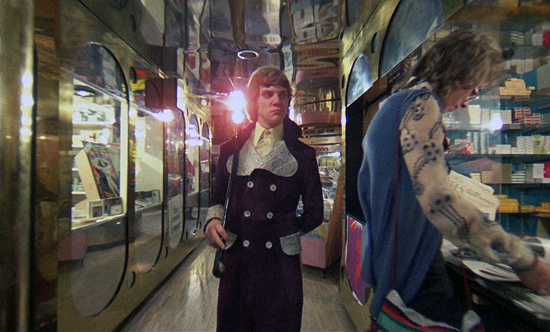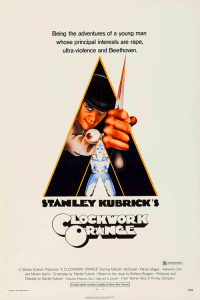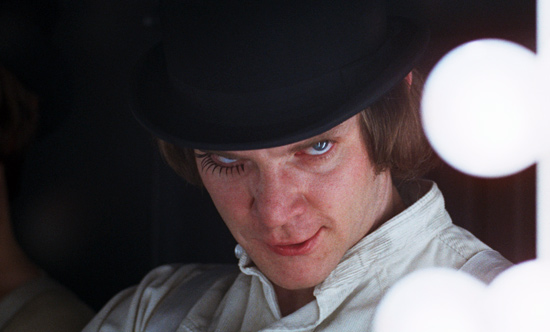
THE FIRST-RUN THEATRICAL ENGAGEMENTS
What follows is a chronological reference listing of A Clockwork Orange’s theatrical openings in the key markets of the United States and Canada. The emphasis is on the largest and earliest markets in which the film played, and the information is designed to provide a sense of the film’s rollout in the early stage of its release in what the industry considers the important and higher-grossing locales.
It should be noted that due to its initial X rating, A Clockwork Orange did not play numerous markets and smaller locales during its first-run period. In some situations the film did play a given market but without the support of any newspaper or radio/TV advertising. Some locales first played the film upon being re-issued with a revised R rating from the MPAA.
The presentations of A Clockwork Orange were in 35mm spherical (1.66:1 aspect ratio) with monaural audio.

Opening Date YYYY-MM-DD … locale – cinema (duration in weeks) [notes]
- 1971-12-18 … Los Angeles – Hollywood Pacific [midnight preview]
- 1971-12-19 … Los Angeles – Hollywood Pacific (41)
- 1971-12-19 … New York – Cinema I (31)
- 1971-12-19 … San Francisco – Metro (30)
- 1971-12-19 … Toronto – Towne (36)
- 1972-02-09 … Boston – Cinema 57 Complex 2 (14 [20])
- 1972-02-09 … Chicago – Michael Todd (18)
- 1972-02-09 … Detroit (Birmingham) – Bloomfield (19)
- 1972-02-09 … Detroit (Grosse Pointe Woods) – Woods II (18)
- 1972-02-09 … Philadelphia – Stage Door (20)
- 1972-02-09 … Washington – The Cinema (20)
- 1972-02-10 … Atlanta – Twelve Oaks (15)
- 1972-02-10 … Houston – Galleria II (15)
- 1972-02-10 … Seattle – Cinerama (18)
- 1972-02-17 … Montreal – Avenue (33)
- 1972-02-17 … Vancouver – Stanley (19)
- 1972-02-24 … St. Louis (Brentwood) – Brentwood (18)
- 1972-02-25 … Charlotte – Charlottetown II (13)
- 1972-03-01 … Minneapolis – Downtown World (12)
- 1972-03-01 … Rochester (Henrietta) – Todd Mart I (16)
- 1972-03-01 … San Jose – Century 22A (24) [w/ Blow-Up during weeks 21-24]
- 1972-03-03 … Syracuse (DeWitt) – Shoppingtown II (12)
- 1972-03-08 … Baltimore – York Road (11)
- 1972-03-08 … Baltimore (Pikesville) – Pikes (11)
- 1972-03-08 … Buffalo (Amherst) – Boulevard Mall I (1+)
- 1972-03-08 … Indianapolis – Glendale IV (11)
- 1972-03-08 … Milwaukee (Wauwatosa) – Mayfair (17)
- 1972-03-08 … New Haven (Orange) – Showcase 2 (10)
- 1972-03-09 … Portland – Irvington (22) [w/ Blow-Up during week 22]
- 1972-03-15 … Cleveland (Woodmere) – Village (15)
- 1972-03-15 … Louisville – Penthouse (15 [17])
- 1972-03-22 … Columbus – University City (10)
- 1972-03-22 … Des Moines – Eastgate I (10)
- 1972-03-22 … Des Moines – Eastgate II (3)
- 1972-03-22 … Pittsburgh – Chatham (9)
- 1972-03-23 … Winnipeg – Polo Park (11)
- 1972-03-24 … Denver – Centre (1+)
- 1972-03-29 … Hartford (Wethersfield) – Paris 2 (16)
- 1972-03-29 … Memphis – Memphian (8)
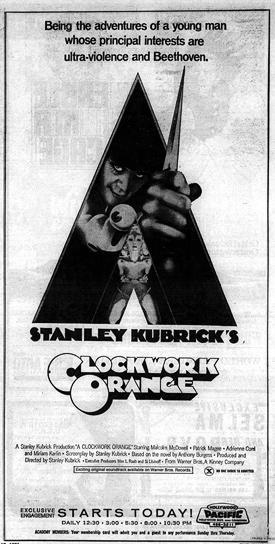 1972-04-05 … Akron (Fairlawn) – Fairlawn (15)
1972-04-05 … Akron (Fairlawn) – Fairlawn (15)- 1972-04-05 … Davenport (Milan) – Showcase 2 (7)
- 1972-04-06 … Ottawa – Little Elgin (20)
- 1972-04-12 … Dallas – Wilshire (17)
- 1972-04-12 … San Antonio – Broadway (11)
- 1972-04-13 … Miami (Coral Gables) – Coral (17)
- 1972-04-13 … Providence – Elmwood (1+)
- 1972-04-19 … Cincinnati – Carousel 1 (10)
- 1972-04-19 … Richmond – Broad Street I (12 [17])
- 1972-04-21 … Little Rock – Center (6)
- 1972-06-14 … Kansas City – Embassy 1 (13)
- 1972-06-14 … Kansas City – Embassy 2 (7)
- 1972-06-15 … Fort Worth – 7th Street (8)
- 1972-06-21 … Albuquerque – Lobo (5)
- 1972-06-21 … Austin – Varsity (7)
- 1972-06-21 … Orlando – Plaza 2 (12)
- 1972-06-21 … Sacramento – Sacramento Inn II (17)
- 1972-06-21 … Tampa – Florida (8)
- 1972-06-21 … Tulsa – Will Rogers (1+)
- 1972-06-22 … Omaha – Six West 4 (12)
- 1972-06-22 … Omaha – Six West 5 (6)
- 1972-06-23 … Dayton – Northwest Plaza (10)
- 1972-06-23 … Las Vegas – Boulevard (5)
- 1972-06-23 … Norfolk – Terrace (1+)
- 1972-06-28 … New Orleans – Cine Royale (15)
- 1972-06-29 … San Diego – Valley Circle (13)
- 1972-07-19 … Honolulu – Cinerama (11)
- 1972-07-21 … Birmingham – Ritz (5)
- 1972-08-09 … Salt Lake City (South Salt Lake) – Century 22 (10)
- 1972-08-11 … Jackson (Flowood) – Town & Country Drive-In I (1 [2]) [w/ Beauty and the Bull]
- 1972-08-16 … Wichita – Twin Lakes II (6)
- 1972-08-25 … Tucson – Buena Vista 1 (3)
- 1972-09-13 … Phoenix (Scottsdale) – Kachina (5)
- 1972-09-29 … Nashville – Green Hills (3)
THE Q&A
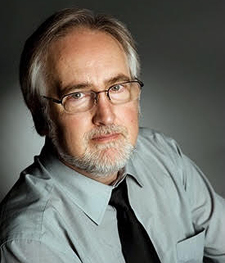 Raymond Benson is the author of over forty published books. He is most well-known as the third—and first American—continuation author of original James Bond novels commissioned by the Ian Fleming Estate, and for his acclaimed and best-selling five-book serial, The Black Stiletto.
Raymond Benson is the author of over forty published books. He is most well-known as the third—and first American—continuation author of original James Bond novels commissioned by the Ian Fleming Estate, and for his acclaimed and best-selling five-book serial, The Black Stiletto.
Raymond has taught Film History college courses in New York and Illinois for years, contributes a regular column and occasional pieces in Cinema Retro magazine (“The Essential Guide to Movies of the ‘60s & ‘70s”), and co-stars in Dann & Raymond’s Movie Club, a monthly live presentation on cinema history in the Chicago area (with Chicago’s Daily Herald film critic, Dann Gire), now in its 15th season. www.raymondbenson.com.
Raymond was previously interviewed for this column’s retrospectives on 2001: A Space Odyssey and The Last Picture Show.
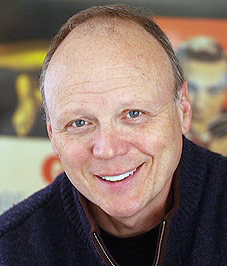 John Cork is the president of Cloverland, a multi-media production company which has produced Value Added Material for numerous home media releases. He wrote the screenplay to The Long Walk Home (1990) starring Whoopi Goldberg and Sissy Spacek, and wrote and directed the feature documentary You Belong to Me: Sex, Race and Murder on the Suwannee River.
John Cork is the president of Cloverland, a multi-media production company which has produced Value Added Material for numerous home media releases. He wrote the screenplay to The Long Walk Home (1990) starring Whoopi Goldberg and Sissy Spacek, and wrote and directed the feature documentary You Belong to Me: Sex, Race and Murder on the Suwannee River.
Cork is the author of James Bond: The Legacy (with Bruce Scivally, 2002), Bond Girls are Forever: The Women of James Bond (with Maryam d’Abo, 2003) and James Bond Encyclopedia (with Collin Stutz, 2007).
John was previously interviewed for this column’s retrospectives on Planet of the Apes, Chitty Chitty Bang Bang and numerous James Bond movies.
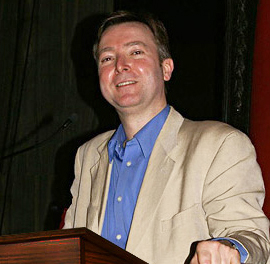 Sheldon Hall is a senior lecturer in film studies at Sheffield Hallam University.
Sheldon Hall is a senior lecturer in film studies at Sheffield Hallam University.
He is the author of Zulu: With Some Guts Behind It—The Making of the Epic Movie (2005), Epics, Spectacles, and Blockbusters: A Hollywood History (with Steve Neale, 2010) and Widescreen Worldwide (with John Belton and Steve Neale, 2010).
Sheldon was previously interviewed for this column’s retrospectives on Around the World in Eighty Days, Jaws and Zulu.
 Peter Krämer is a Senior Research Fellow in Cinema & TV in the Leicester Media School at De Montfort University.
Peter Krämer is a Senior Research Fellow in Cinema & TV in the Leicester Media School at De Montfort University.
He has published four books on Stanley Kubrick, including the volume on A Clockwork Orange in Palgrave’s “Controversies” series.
He is also the author of The New Hollywood: From Bonnie and Clyde to Star Wars (2006) and The Hollywood Renaissance: Revisiting American Cinema’s Most Celebrated Era (with Yannis Tzioumakis, 2018).
Peter was previously interviewed for this column’s retrospectives on 2001: A Space Odyssey, Funny Girl and Raiders of the Lost Ark.
The interviews were conducted separately and edited into a “roundtable” conversation format.
Michael Coate (The Digital Bits): How do you think Stanley Kubrick’s A Clockwork Orange should to be remembered on its 50th anniversary?
John Cork: A Clockwork Orange should be remembered as one of the most visually compelling, aurally seductive, audaciously engaging, and intellectually confounding movies ever made. It is a film that many have hated themselves for loving, that has spurred on countless hours of late-night dissections in college dorms, and, as we know, inspired a few to embrace the violent ethos of Alex and his Droogs. It is a film that refuses to be ignored, and a film that provokes and provides no simple answers to the questions it poses.
Raymond Benson: It’s nothing short of bravura filmmaking. Intelligent, courageous, innovative, surprising, mind-boggling, disturbing, exciting, funny—all these descriptions apply to A Clockwork Orange. It was a novel by Anthony Burgess that was deemed “unfilmable,” and yet, Kubrick did it. It will be remembered as a controversial, dynamic piece of art that still divides audiences, and it’s easily one of Stanley Kubrick’s defining masterworks.
Peter Krämer: Living in the UK, I probably should say that first and foremost A Clockwork Orange has to be remembered as arguably the most controversial film in British history. The public debate about the film was so heated that Kubrick, in 1976, asked Warner Bros. not to go ahead with the planned theatrical re-release of the film in the UK. Indeed, A Clockwork Orange was not legally available in any format in this country until the year after Kubrick’s death in 1999. The initial response to the film was deeply divided. While the British Board of Film Censors had passed it without cuts, various local authorities banned it and the BBFC was severely criticized for being too lenient. And while London film critics loved the film from the outset, and it was a massive box office hits during its incredibly long run in British cinemas, all kinds of commentators, politicians, campaigners etc. attacked the film. It was referenced in several court cases to do with the crimes of young people who, supposedly (and very fancifully), had somehow been influenced by the violence of the youngsters in the movie. It is fascinating to read the hundreds of newspaper articles published during and after the movie’s theatrical release in the UK. In addition to juvenile crime many aspects of British society—modern architecture, family breakdown, the prison system etc.—were being discussed with reference to A Clockwork Orange. The film seemed to have to say something about all of this, or, at the very least, it was useful for illustrating some point or other that a writer wanted to make about contemporary Britain. So half a century later, it may still serve as a window into the early 1970s, although, at the same time, it also transcends its original historical context, having long become a timeless masterpiece.
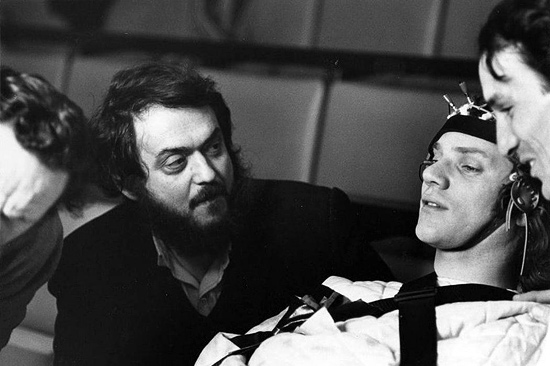
The Digital Bits: What was your first impression of the film?
Benson: I first saw it in the summer of 1973, as I was a year shy of seeing it when it was still X-rated in late ‘71 and all of ‘72 (although I tried!—but the box office person was annoyingly strict about the admittance policy). Kubrick himself withdrew the picture temporarily in late ‘72/early ‘73 to make two cuts that totaled around thirty seconds, and the movie was re-rated R in the States. It was re-released that way and I saw it then. (As I understand it, though, those miniscule cuts are back in the film on home video and the R rating remains intact.) By the time I did see it, I knew all about it. I’d read the published “storyboard” screenplay that illustrated the entire movie, and I had read the novel. It was likely my most anticipated film of that era, having had my life changed (literally!) after seeing 2001: A Space Odyssey on first release. Interestingly, I find A Clockwork Orange much more difficult (unsettling) to watch today than back in the 70s. Back then, the sex and violence were all part of cinema’s new freedom that began in the late 60s with the collapse of the Production Code and initiation of the ratings in the U.S. It was a time when filmmakers were pushing the envelope to see what they could get away with, and audiences were more accepting of what was on the screen. Rapes depicted in movies are perceived quite differently today by the Gen Z crowd, as I’ve noted in the recent Film History college classes that I taught. One must place the film within the context of when it was released.
Cork: My first interaction with the film was when my mother, then dating my future adoptive father, went to see it. I had read something about the controversy over it, and demanded that she tell me about the plot (something I did with most of the movies she saw on dates). Later, when cable television came to my hometown of Montgomery, Alabama, my grandparents subscribed to HBO, and in December 1977, I had the chance to watch A Clockwork Orange for myself. I was 16, and it was one of the most chilling, mesmerizing, fascinating films I had ever seen. I must have seen it six or seven times over the next few months. Like many, I loved imitating Alex’s speech patterns. “Welly, welly, welly, welly, welly, welly, well!” Sometimes I didn’t “see” something, but I “viddied” it. If a new song was good, I might comment on “angel trumpets and devil trombones.” That said, I could be inspired by Alex’s style and swagger, but had nothing but repulsion for his ethics and lust for a bit of the old ultraviolence.
Krämer: This may sound odd, but watching A Clockwork Orange at my local cinema when I was a teenager in late 1970s West Germany really helped to change my life. I was simply overwhelmed by the film, and I felt so strongly about its odd mixture of sex, violence, humor, beauty, social commentary and philosophical reflection that almost immediately I had to see it again—and I had to write about it. In those days there was nothing like “Film Studies” at German schools, but there was a class on communications, and I decided that, together with a friend who was deeply impressed by the movie as well, I would do an extensive study of A Clockwork Orange—but it had to be the novel. Really we were working through the impact the film had had on us, and we used the novel to do so. Which was not a problem for me because I had read the novel before. In fact, I was first and foremost an avid reader of all kinds of Science Fiction and only secondarily a cinephile. But with Kubrick’s A Clockwork Orange and 2001: A Space Odyssey, which I watched around the same time, suddenly movies did become much more central to my life—and this, eventually, lead to me studying film at university and becoming a film scholar. As I said: A Clockwork Orange helped to change my life!
